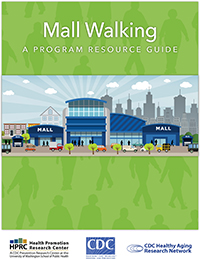“Mall Walking: A Program Resource Guide” is informed by research from the University of Washington Health Promotion Research Center (UW HPRC). It is sponsored and co-authored by the U.S. Centers for Disease Control and Prevention (CDC) and provides information about the health benefits of mall walking and to present practical strategies for starting and maintaining walking programs in malls and other venues. The information supports the CDC’s National Prevention Strategy and is based on evidence showing great potential in mall walking programs for health improvement among older adults with varying physical abilities.
Health Benefits
Walking is a great way to increase physical activity. It requires no special skills or expensive equipment. Some barriers may exist, however, to prevent someone from being physically active. For example, many neighborhoods lack sidewalks, have busy traffic, and sometimes have a high level of crime. Weather can also play a role in someone’s decision to not engage in walking.
Mall walking offers a safe, free, comfortable, and relatively-accessible, pedestrian-friendly way for the public to walk. The guide explains how mall walking helps people overcome barriers to physical activity by providing:
- Climate-controlled, indoor environment
- Mall security staff along with the presence of other walkers and shoppers
- Accessibility to level surfaces, which can reduce the risk of slips and falls
- Social support from fellow mall walkers
- Well-lit restrooms and access to free water fountains
Evidence Based
The guide is a great tool with strategies for established mall walking programs, and for groups and individuals who want to start a mall walking program. It is informed by research that included a literature review, environmental audits of malls and other venues used for walking programs, and data from interviews conducted with walkers, managers, and providers of walking programs. The guide also has information about and examples of other locations in areas where a mall is not available, such as zoos, botanical gardens, and commercial spaces.
Physical activity, such as walking, can help improve health. People who are physically active live longer and have a lower risk for heart disease, stroke, type 2 diabetes, depression, and some cancers. Improving spaces and having safe places to walk can help more people become physically active. This guide is useful for mall managers and others promoting and improving places for people who have varying physical abilities to benefit from physical activity.

The “Mall Walking: Program Resource Guide” won the 2016 APEX Award-winning Action Guide.
